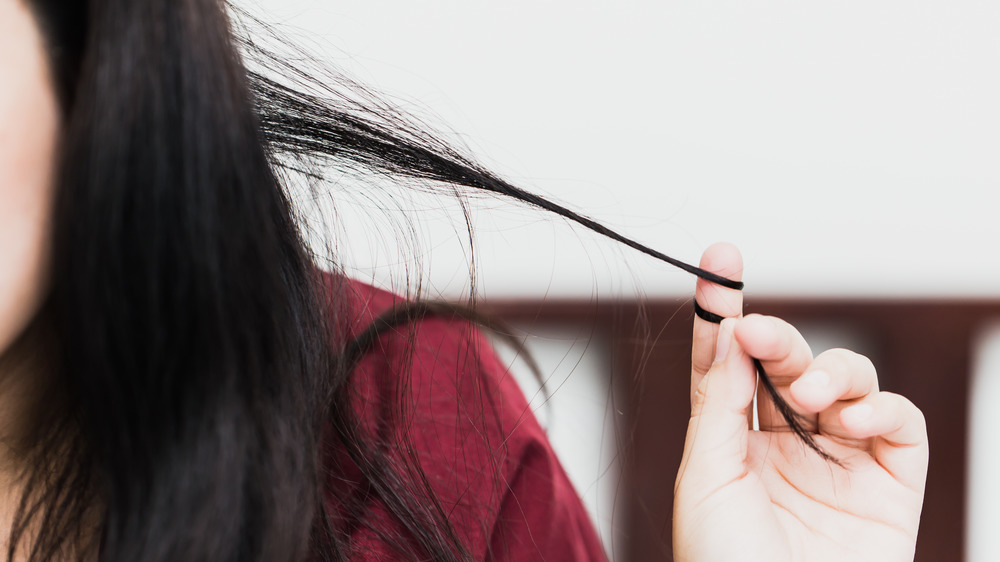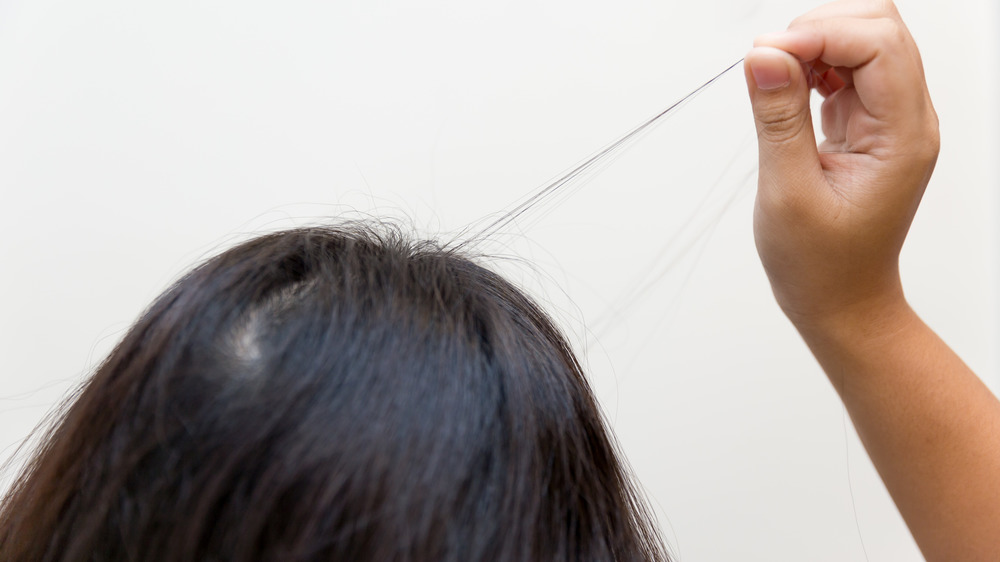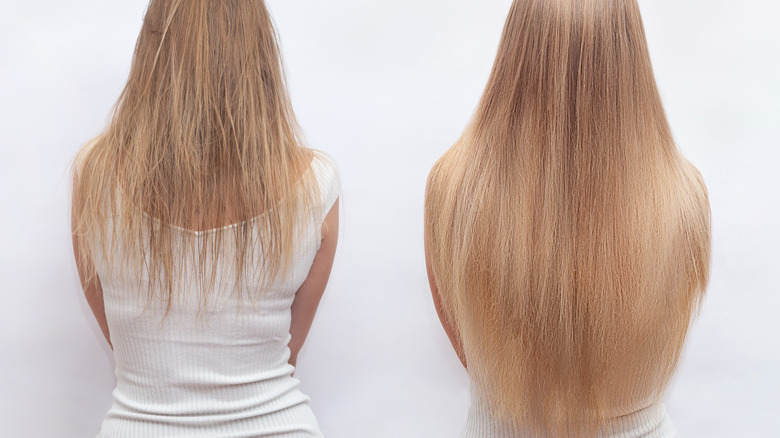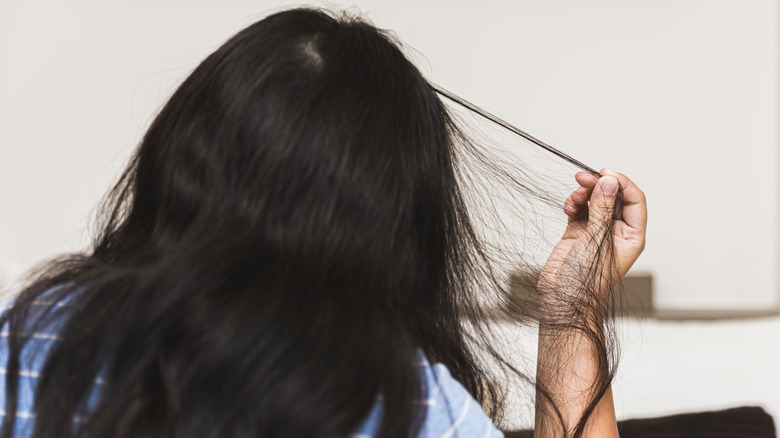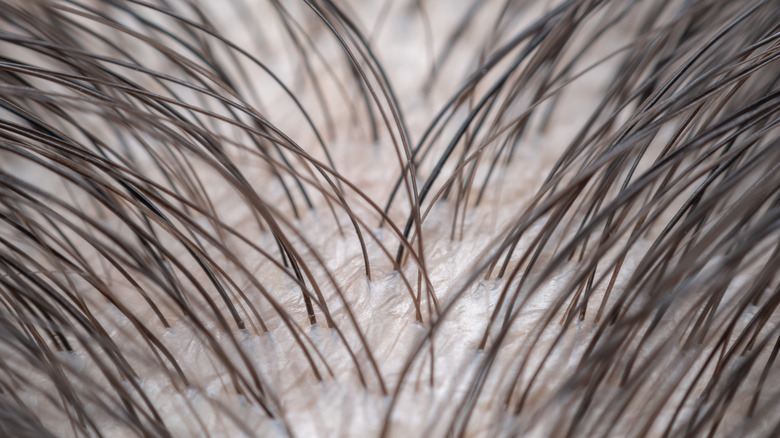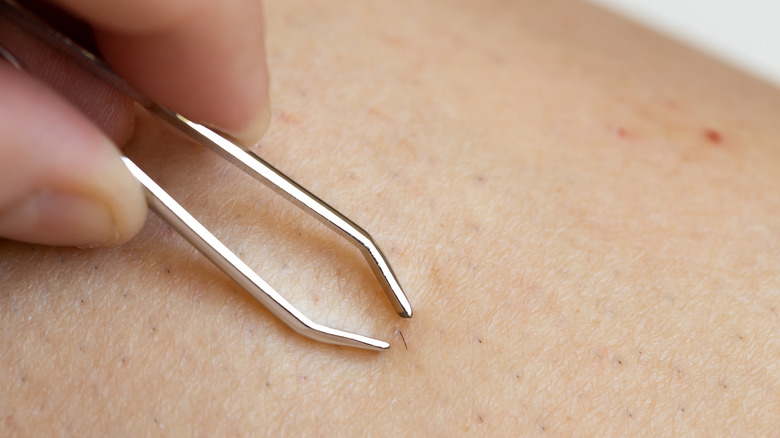What Happens If You Accidentally Pull Out Your Hair Follicle?
Losing hair is a completely natural part of life. In fact, according to the American Academy of Dermatology (AAD), an individual loses 50 to 100 hairs per day. That's because hair growth is a process and at any given moment, many of the 100,000 hair follicles on your scalp are working to grow new hairs to replace the ones that fall out (via Healthline). If you've pulled out a hair, whether by accident or on purpose, you may notice what appears to be a hair follicle at the end. However, there's no need to worry, as it's virtually impossible to pull out a hair follicle. Hair will typically grow back unless it was from a follicle that has stopped producing hair.
A hair follicle is a permanent part of the skin situated in the epidermis or the skin's top layer. It contains your hair bulb and the hair itself. When you pull out a hair by the root, what you are seeing at the end is the hair bulb, not a hair follicle. A hair bulb is surrounded by nerve fibers, which allow you to feel when your hair is moved, touched, or pulled. While pulling out a hair from its root may cause temporary damage to the hair follicle, a new hair bulb will eventually form, and hair will grow again.
How long will it take hair to grow back?
Determining how long it takes hair to regrow isn't an exact science. But if the hair follicle wasn't damaged when the hair was pulled out, standard growth should be expected. According to the AAD, hair on the scalp grows up to six inches per year and continues to grow for about eight years.
For people with trichotillomania, a disorder that involves repetitive, irresistible urges to pull out hair from the scalp or other parts of the body, the length of time it takes hair to grow back is typically longer. Frequent damage to the hair follicle caused by repeated pulling can slow growth down. According to the TLC Foundation, a nonprofit organization dedicated to supporting those who have body-focused repetitive behaviors like trichotillomania, it may take two to four years for new hair to grow if a hair follicle has been damaged.
If left untreated, trichotillomania can leave a hair follicle permanently damaged and make future hair growth from that follicle difficult or even impossible. In extreme cases, individuals with the disorder may be left with small patches of skin where hair would normally grow. The good news is, when treated, most recovered people with trichotillomania report hair growth after a period of months or years where it didn't seem like it would grow back initially.
Different stages of hair growth
Hair growth occurs in a cycle, lasting for various lengths of time and dependent on factors such as your health and nutrition as well as your genes and stress levels, per Healthline. There are four specific stages of hair growth: anagen, catagen, telogen, and exogen (via Healthline).
The anagen stage lasts the longest and occurs when the hair follicle is in the process of growing out a strand of hair. Anagen phases can last up to 7 years for some people, although this varies depending on the part of your body that is growing hair, per Healthline. The hair on your legs or underarms cannot grow as long as the hair on your head because the anagen phase of those body parts is much shorter in duration, per WebMD.
The catagen phase of hair growth is the shortest stage, lasting for only a couple of weeks, per WebMD. This transition stage occurs when the hair growth from the follicle stops and attaches itself to the hair root. Hairs that are in the telogen phase are considered to be in a rest period, with no new hair growing and none falling out, per Healthline. You'll likely notice when your hair is in the exogen phase, as this is the stage of the cycle when your hair sheds and may show up on your hairbrush. This occurs because there is a new strand of hair pushing the old hair out of the follicle (via Healthline).
How to manage trichotillomania
While health professionals are not sure how trichotillomania develops, they do consider it a mental health issue with symptoms commonly starting between ages 10 and 13, per Healthline. Those who have trichotillomania often feel relief from stress and anxiety after they begin pulling out hairs, although they may not even realize what they are doing at first, per Healthline. There is a lot of embarrassment, anxiety, and a sense of shame that can result from having trichotillomania, but luckily, there are ways to help control it.
Trichotillomania can be managed with different types of therapy. The most common type of therapy for the disorder is called habit reversal training, per Mayo Clinic. With habit reversal training, patients are taught to recognize the triggers surrounding their behavior and practice swapping out hair pulling for another method of coping. Cognitive-behavioral therapy (CBT) is another popular method for managing trichotillomania and involves encouraging the patient to explore and eventually change the beliefs and attachment they have toward hair pulling, per Mayo Clinic.
Why are some hair bulbs bigger than others?
Hair bulbs, located at the root of your hair, are the see-through bulbs that you may notice after pulling out a few hairs (via TLC Foundation). WebMD explains that these little bulbs, which are situated inside the hair follicle, are where the action happens because they contain the cells that cause your hair to grow.
According to the TLC Foundation, these bulbs can vary in size depending on what stage of growth your hair was in when it was pulled out. If the strand of hair is in the exogen or shedding phase, the bulb will be much smaller or you may not see one at all. The bulbs on hair that have been pulled out during the earlier phases of hair growth will be much larger than the ones on the hairs that you naturally shed in the shower or on your hairbrush.
Should you pull out ingrown hairs?
Ingrown hairs occur when a strand of hair ends up getting stuck under the skin and hair follicle instead of growing up and out as it typically would (via Cleveland Clinic). Commonly occurring on the bikini area, face, neck, and underarms, ingrown hairs can be painful especially if they become inflamed or infected, per Mayo Clinic. They often resemble acne and can be caused by waxing, shaving, or tweezing hairs, as well as not showering after sweating, per Cleveland Clinic.
According to the Cleveland Clinic, it's not a good idea to try and pull out an ingrown hair. Instead, you can treat and prevent them by allowing the steam of the shower to open up your pores and follicles before you shave. You can also regularly exfoliate and try products containing salicylic acid or beta hydroxyls. This will help to slough off dead skin cells, leaving your pores clear and therefore less likely to develop ingrown hairs.

